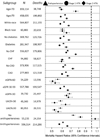Blood pressure and mortality in U.S. veterans with chronic kidney disease: a cohort study
- PMID: 24026256
- PMCID: PMC4155539
- DOI: 10.7326/0003-4819-159-4-201308200-00004
Blood pressure and mortality in U.S. veterans with chronic kidney disease: a cohort study
Abstract
Background: The ideal blood pressure (BP) to decrease mortality rates in patients with non-dialysis-dependent chronic kidney disease (CKD) is unclear.
Objective: To assess the association of BP (defined as the combination of systolic BP [SBP] and diastolic BP [DBP] at the individual level) with death in patients with CKD.
Design: Historical cohort between 2005 and 2012.
Setting: All U.S. Department of Veterans Affairs health care facilities.
Patients: 651 749 U.S. veterans with CKD.
Measurements: All possible combinations of SBP and DBP were examined in 96 categories from lowest (<80/<40 mm Hg) to highest (>210/>120 mm Hg), in 10-mm Hg increments. Associations with all-cause mortality were examined in time-dependent Cox models with adjustment for relevant confounders.
Results: Patients with SBP of 130 to 159 mm Hg combined with DBP of 70 to 89 mm Hg had the lowest adjusted mortality rates, and those in whom both SBP and DBP were concomitantly very high or very low had the highest mortality rates. Patients with moderately elevated SBP combined with DBP no less than 70 mm Hg had consistently lower mortality rates than did patients with ideal SBP combined with DBP less than 70 mm Hg. Results were consistent in subgroups of patients with normal and elevated urinary microalbumin-creatinine ratios.
Limitation: Mostly male patients, inability to establish causality, and large number of patients missing proteinuria measurement.
Conclusion: The optimal BP in patients with CKD seems to be 130 to 159/70 to 89 mm Hg. It may not be advantageous to achieve ideal SBP at the expense of lower-than-ideal DBP in adults with CKD.
Primary funding source: National Institute of Diabetes and Digestive and Kidney Diseases, National Institutes of Health, and U.S. Department of Veterans Affairs.
Conflict of interest statement
None of the authors have relevant conflicts of interest.
Figures


Comment in
-
How low can you go? Blood pressure and mortality in chronic kidney disease.Ann Intern Med. 2013 Aug 20;159(4):302-3. doi: 10.7326/0003-4819-159-4-201308200-00014. Ann Intern Med. 2013. PMID: 24026262 No abstract available.
References
-
- Lewington S, Clarke R, Qizilbash N, Peto R, Collins R. Age-specific relevance of usual blood pressure to vascular mortality: a meta-analysis of individual data for one million adults in 61 prospective studies. Lancet. 2002;360(9349):1903–1913. - PubMed
-
- Whelton PK, He J, Appel LJ, Cutler JA, Havas S, Kotchen TA, et al. Primary prevention of hypertension: clinical and public health advisory from The National High Blood Pressure Education Program. JAMA. 2002;288(15):1882–1888. - PubMed
-
- Gasowski J, Fagard RH, Staessen JA, Grodzicki T, Pocock S, Boutitie F, et al. Pulsatile blood pressure component as predictor of mortality in hypertension: a meta-analysis of clinical trial control groups. J Hypertens. 2002;20(1):145–151. - PubMed
-
- van den Hoogen PC, Feskens EJ, Nagelkerke NJ, Menotti A, Nissinen A, Kromhout D. The relation between blood pressure and mortality due to coronary heart disease among men in different parts of the world. Seven Countries Study Research Group. N Engl J Med. 2000;342(1):1–8. - PubMed
-
- Vasan RS, Larson MG, Leip EP, Evans JC, O'Donnell CJ, Kannel WB, et al. Impact of high-normal blood pressure on the risk of cardiovascular disease. N Engl J Med. 2001;345(18):1291–1297. - PubMed
Publication types
MeSH terms
Substances
Grants and funding
LinkOut - more resources
Full Text Sources
Other Literature Sources
Medical
